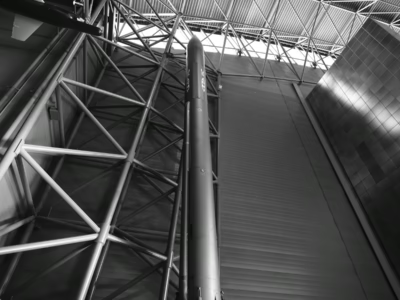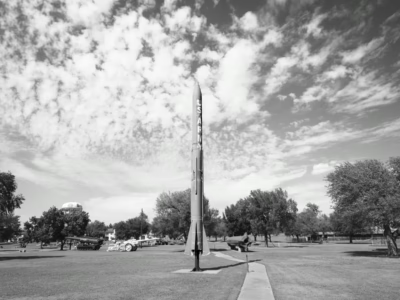Corporal
The first nuclear missile

The Corporal was in development for many years and suffered many setbacks. Nevertheless, it represents an important milestone in weapons history and in preparing the way for the missiles that would come in the future. Photo from the US Space and Rocket Center in Huntsville.

When photographing missiles one tends to lean backwards, giving the impression to those not familiar with the weapon, that they are towering constructions. This image, made at the US Space and Rocket Center in Huntsville, Alabama, helps give a more correct scale–the Corporal is about forty-five feet tall.

The Corporal was a troubled design with a high failure rate, even in its final form, and took 250 men and nine hours to set up, requiring some of the men to wear awkward protective clothing due to the missile’s toxic and corrosive liquid fuel. Corporals traveled in pairs and one battalion could launch four missiles per day. This unit is at the Smithsonian Air and Space Museum Annex in Chantilly, Virginia.

The Corporal was guided by radio and, once in flight, armed by radio, which subjected the weapon to the possibility of natural interference and enemy jamming. If the signal was jammed before arming the missile would nevertheless continue on its path toward the target. This Corporal is on view outside the Ft. Sill Artillery Museum, in Oklahoma.
Explosive Power
20 kt.
Hiroshima Equivalent Factor
1.33x
Dimensions
45 ft, 4 inches x 30 inches
Weight
5.5 tons
Year(s)
1954-1964
Range
30-75 miles
Purpose
First guided nuclear missile
Nukemap
NUKEMAP is a web-based mapping program that attempts to give the user a sense of the destructive power of nuclear weapons. It was created by Alex Wellerstein, a historian specializing in nuclear weapons (see his book on nuclear secrecy and his blog on nuclear weapons). The screenshot below shows the NUKEMAP output for this particular weapon. Click on the map to customize settings.

Videos
Click on the Play button and then the Full screen brackets on the lower right to view each video. Click on the Exit full screen cross at lower right (the “X” on a mobile device) to return.
Further Reading
- Wikipedia
- Nuclear historian Brian Burnell has an extraordinarily good page on the Corporal, covering not only the weapon and its development in clearly written detail but also does two things that are oddly rare: he offers a comparison to the relevant Soviet weaponry (in this case the Scud missile) and explains why the US military wanted this particular weapon in the first place. Well worth a look.
- Two other histories of the Corporal might be of interest: “The Corporal M2 Missile” by Peter A. Goetz in WarefareHistoryNetwork.com offers a survey of the missile’s development (and a few nice photos of the Corporal) while “The Corporal Family of Rockets and Missiles” published by the White Sands Missile Range Museum delves deeper into the pre-history of the Corporal, covering not only earlier missiles and rockets but the Jet Propulsion Laboratory’s role in the research ad development of this new technology.
- The Army which, despite shortcomings of the Corporal, sees the weapon as the beginning point of later achievements, has its own history in the oddly named “Development of the Corporal: The Embryo of the Army Missile Program” and its supporting documents.
- For a sense of the weapon’s difficult birth (without diving deep into one of the histories listed above) look at the US Army’s chronology, put out by the Aviation and Missile Life Cycle Management Command. Also, as an indication of the weapon’s importance in terms of technology development, note how many times the word “first” appears.
- The Corporal was a difficult (and dangerous) weapon to use as suggested by this graduation photo from the 1952 class of the The Corporal Guided Missile Training School at White Sands–two years before the Corporal entered service. Also note this photo, made at the University of Illinois, of a mobile Corporal unit erected on campus in 1960 order to gin up interest among the students in a career in the military. This photo shows what appears to be that same missile at another location on campus.
- The folks at Jet Propulsion Laboratory had a sense of humor, it seems, and produced this humorous version of a standard Air Force reel.
- The Corporal used a W7 warhead, a modification of the Mark 7 bomb, which was also used for Honest John, BOAR, the early version of the Nike Hercules, the “Betty” nuclear depth bomb, and the ADM (Atomic Demolition Munition). [Links to American Nukes forthcoming.]